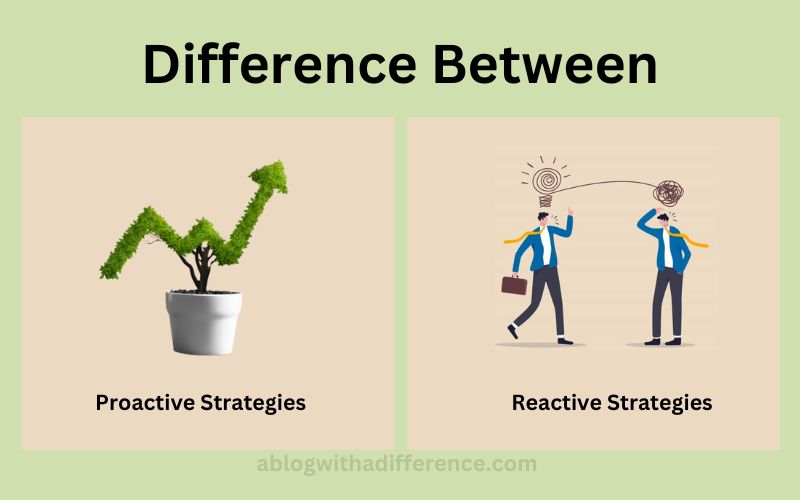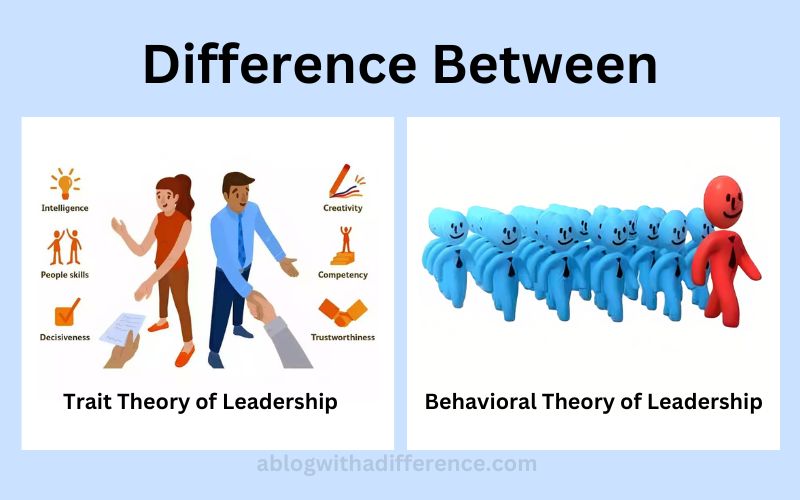Difference Between Proactive and Reactive Strategies
A brief introduction to Proactive and Reactive Strategies
Reactive and proactive approaches differ mainly by their goal; proactive methods aim to anticipate an event by being proactive about prevention while reactive tactics focus on reacting after an incident has already taken place.
Reactive and proactive strategies are two strategies frequently employed both within business environments as well as the everyday lives of people. Though both strategies are equally necessary for the success of any organization, there is an essential distinction between reactive and proactive approaches that allow businesses to thrive.
Proactive strategies are employed by businesses to anticipate potential threats and challenges; reactive strategies involve responding to unanticipated incidents as soon as they arise.
Importance of understanding the difference between proactive and reactive strategies
An understanding of reactive and proactive strategies is vitally important, both personally and for businesses alike.
Here are a few reasons why it’s so Crucial:
1. Strategies for Preparation: Proactive strategies can assist Individuals and businesses alike to anticipate and plan for potential challenges or problems that might arise in the future, by assessing and responding to potential threats or opportunities in advance. These proactive plans provide better preparedness and reduce the chance of being caught out unexpectedly.
2. Control and Influence: Strategies of Control and Influence enable individuals and companies to exert greater control over events, creating outcomes that meet their objectives and goals. By being proactive rather than reactive you can help shape events rather than reacting solely to them.
3. Long-Term Success: Proactive strategies are key for long-term success, providing both organizations and individuals the means to enhance their resilience, enhance processes, and realize sustainable growth.
By opting for preventive measures and continuous improvements, proactive strategies enable long-term resilience improvements as well as sustainable growth; in contrast to reactive approaches which often require short-term fixes that result in inefficiency or missed opportunities later on.
4. Resource Optimization: Adopting proactive strategies can allow for the more effective allocation of resources. By anticipating potential issues or risks early, resources can be allocated in ways to address or mitigate them more quickly – thus decreasing emergency firefighting costs and any associated liabilities.
5. Reputation Management: Effective strategies help individuals and businesses maintain a good reputation. By monitoring any potential dangers or negative events before they escalate, individuals and businesses can protect their names by acting swiftly to address potential dangers or negative events before they damage their brand. On the contrary, reactions usually include damage control which is less effective at mitigating reputational loss.
6. Performance and Efficiency: Effective strategies increase efficiency and effectiveness by dealing with issues before they cause disruptions. By identifying areas of improvement and taking preventive steps both individuals and companies will find that their processes become streamlined, workflows enhanced, and disruptions decreased, which results in greater productivity and efficiency.
7. Innovation and Growth: Strategies that are proactive are instrumental in creating an environment conducive to growth and innovation. By actively seeking new opportunities and trends, anticipating them, and adapting to changes in their environments people and companies can stay ahead of trends while taking advantage of new ones – further encouraging innovation and encouraging growth.
Understanding the difference between Reactive and Proactive strategies is vital for both Organizations and individuals to successfully navigate through difficult situations, capitalize on opportunities, and ensure long-term success.
Proactive approaches include preparation control, resource optimization, and reputation management as well as productivity, efficiency, and creativity – all contributing towards increased growth and resilience of an organization.
What are proactive strategies?
Proactive strategies are preemptive steps taken in advance to prepare or prepare for anticipated events, challenges or opportunities. Such plans include actively searching out potential risks, analysing trends, and making educated decisions to change outcomes and alter developments of events.

Proactive approaches involve individuals or teams taking initiative and acting to reduce risks and take advantage of opportunities in order to accomplish their goals. This may involve conducting comprehensive risk analyses, setting specific goals when it comes to preventive measures implementation, and cultivating an environment which fosters continuous improvement.
Proactive plans aim to prevent problems and disruptions by anticipating their occurrence, discovering them early, and acting upon them before they take place. This requires adopting an assertive mentality, planning strategically, investing time, effort, and resources in proactive measures.
Strategic approaches that are proactive aim to reduce risks, increase efficiency and enhance competitiveness to achieve long-term success by designing rather than simply responding to events as they unfold.
What Are Reactive Strategies?
Reactive strategies are methods and approaches used in response to unexpected situations, difficulties or urgent needs. Reacting immediately as circumstances emerge to address immediate issues as well as dealing with incidents not anticipated beforehand are among its many applications.
Reactive strategies require individuals and teams to react rapidly and impulsively when reacting to current conditions, often without prior planning. Their aim is to minimize sudden events’ negative impacts as quickly as possible while resolving immediate issues and returning normal operations as soon as possible.
Reactive strategies require quick decision-making, the capacity to manage crises quickly and adapting quickly to an ever-evolving environment. Reactionary plans involve taking corrective action, implementing contingency plans and mobilizing resources in response to any issue or event at hand.
Proactive strategies aim to prevent problems from emerging while reactive measures should only be employed if preventive measures prove insufficient or immediate actions must be taken immediately. Reactive approaches are indispensable in responding to emergencies or solving urgent problems quickly while mitigating further harm and side effects from their onset.

Reactive strategies should never be seen as the main strategy, but should instead be employed alongside proactive ones as necessary to address unexpected situations that couldn’t have been fully predicted in advance.
Organizations and individuals can utilize proactive and reactive strategies to effectively manage risks and address challenges, while remaining resilient in an ever-evolving environment.
Comparison Chart of Proactive and Reactive Strategies
Here’s a chart of comparison that highlights the main difference between proactive and reactive strategies:
| Topics | Proactive Strategies | Reactive Strategies |
|---|---|---|
| Approach and Mindset | Anticipation, forward-thinking, prevention | Reliable, responding to immediate requirements |
| Timing and Initiation | It is initiated prior to issues arising. | It is initiated as a response to events or issues |
| Focus | Prevention, preparedness, long-term planning | Rapid response, immediate repair and damage control |
| Benefits | Risk mitigation, efficiency, innovation, long-term success | Rapid response quick response, crisis management, control |
| Drawbacks | Resources-intensive, but may not account for every scenario. | Insufficient planning prior to the start Temporary solutions |
| Steps for Implementation | Set goals, assess risks create a culture, and develop actions strategies | Develop response plans, train for emergencies, establish communication channels |
| Learning Approach | Continuous improvement, learning from failures and successes | Analyzing the aftermath of an incident, learning from the reactive situation |
| Integration | Active measures to limit the necessity of reacting | Reactive strategies complement proactive efforts |
Implementing Proactive Strategies
Implementing proactive strategies requires an organized and systematic approach in order to predict issues, identify opportunities and create the future.
Here are several steps for adopting proactive strategies:
1. Assess Risks and Vulnerabilities:
- Consider any risks and weaknesses that could thwart your business goals or plans.
- Conduct comprehensive risk analyses that encompass both internal and external elements.
- Prioritize risks based on their impact and likelihood.
2. Set Goals and Targets:
- Establish goals that align with your company’s vision and mission, with clear metrics to measure them against.
- Set specific goals that will assist in the execution of your strategy.
- To meet their goals and objectives in a timely manner.
3. Establish an atmosphere of anticipation and preparation:
- Foster an environment in which teams and individuals feel more proactive within the company.
- Promote learning and continual advancement in innovation, creativity and forward-thinking.
- Foster an environment in which colleagues share ideas, insights and best practices related to developing proactive strategies.
4. Create Action Plans:
- Whilst considering risks and striving to meet goals efficiently is important, so too are creating detailed action plans as soon as they have been identified and addressing them quickly and proactively.
- Establish the necessary tasks, their responsibilities and timelines for completion.
- Allocate resources like personnel, budget and technology to support proactive initiatives.
5. Take Preventative Measures:
- Implement your action plans through preventive measures and controls.
- Implement strong security protocols, safety procedures or quality assurance processes.
- Consider adopting automation and technology solutions to enhance the efficiency and effectiveness of preventive actions.
6. Evaluate and assess Your Progress:
- Maintain an ongoing review and assessment of proactive strategies.
- Establish Key Performance Indicators (KPIs) to assess the success of proactive initiatives.
- Conduct regular reviews and tests to identify areas for improvement, then make any necessary adjustments.
7. Foster collaboration and increase communication:
- Incentivize cross-functional collaboration and information exchange.
- Establish effective communication channels to coordinate proactive actions effectively.
- Engage employees, stakeholders and other relevant parties in the proactive execution process.
8. Draw insight from past experiences to make necessary changes:
- Learn from both successes and failures, implementing proactive plans.
- Analyse results and lessons learned, to be proactive with future efforts and improve them accordingly.
- Incorporate feedback and information into the ongoing implementation of strategy.
Know that successful implementation of proactive strategies requires dedication, commitment and a long-term approach. As your business’s environment shifts and evolves, so must your plans. Therefore it is imperative that they are regularly evaluated and revised as your plans adapt with changing conditions.
Implementing a proactive mindset and method in your company allows you to better recognize challenges, reduce risks and establish the basis for long-term prosperity.
Integrating Reactive Strategies
Integrating reactive strategies with proactive ones is vital for successfully handling unexpected incidents like emergencies, crises, or urgent requirements.
Here are the steps you must take to integrate reactive management strategies into your overall plan:
1. Construct effective response plans:
- Devise comprehensive plans of action to respond to various kinds of crises or emergencies that could occur.
- Establish clear roles, actions, and responsibilities for various department members or team members during emergencies.
- The plan of action should contain protocols for communication, escalation processes, and decision-making frameworks.
2. Prepare and train for emergency scenarios:
- Engage in regular training and exercises designed to equip both teams and individuals for situations requiring swift responses.
- Provide training on emergency management, crisis procedures, and effective communication during stressful situations.
- Make sure everyone understands their roles and responsibilities so they can respond promptly if something arises.
3. Establish Communication Channels:
- Build efficient communication networks that facilitate rapid responses during reactive events.
- Establish primary and backup channels of communication such as phones, emails, or messaging apps as well as emergency notification systems.
- Establish a clear protocol for communication. Establish who needs to be informed when, how often, and via which channels.
4. Keep Abreast: Maintain situational awareness:
- Constantly collect relevant data to maintain situational awareness for reactive situations.
- Keep abreast of current developments by using tools like live monitoring, real time data analysis, or monitoring social media.
- Update and distribute key information regularly to assist appropriate teams or individuals in making well-informed decisions.
5. Learn from reactive situations:
- Perform an in-depth post-incident investigation, analysis, evaluation, and review after reactive events take place.
- Outline lessons learned, root causes, and areas for improving response and preparation.
- Utilize knowledge gained from reactive situations to develop more proactive approaches, for instance by reviewing risk analyses, updating response plans, or taking preventive steps.
6. Continuously enhance your reactive capabilities:
- Regularly review and revise response plans in light of customer feedback, lessons learned, and changes in an operational environment.
- Discover ways to increase your ability to react, such as investing in new technologies, upgrading emergency equipment, or improving communications systems.
- Promote an environment of continuous improvement when responding to emergencies through ongoing training and knowledge-sharing.
7. Coordinating reactive and proactive efforts:
- Promote cooperation and coordination between reactive and proactive departments or teams.
- Establish mechanisms to facilitate sharing of information, knowledge, and lessons learned across reactive and proactive functions.
- Make sure that proactive strategies take into account potential reactive scenarios, and include appropriate countermeasures for these.
By including reactive strategies in your overall plan, it is possible to quickly respond to unexpected incidents and maintain operational resilience. The key is finding an equilibrium between proactive and reactive measures by adopting strategies that reduce the need for reactive responses whenever possible.
Conclusion
Active and reactive strategies are indispensable tools for teams, individuals, and companies alike in overcoming challenges, mitigating risks, and meeting objectives. Proactive strategies focus on prevention, anticipation, and planning. They involve identifying risks and goals while taking proactive measures and cultivating an attitude of proactiveness.
Proactive methods enable individuals and companies alike to manage risks effectively, improve decision-making efficiency, allocate resources efficiently, improve long-term performance, and enhance sustainability.


